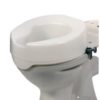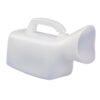Incontinence is described as passing urine involuntarily and is a very common problem. There are many different types of incontinence each related to different conditions.
- Stress incontinence
- Urge incontinence
- Functional incontinence
- Overflow incontinence
- Mixed incontinence
- Transient incontinence
1.Stress Incontinence
This type of incontinence is caused by any physical movement such as laughing, coughing or sneezing. It is more common in women as it is often due to physical changes in the body such as pregnancy, childbirth or menopause.
What causes it?
The sphincter pelvic muscles help support the bladder and urethra which control the flow of urine. When these muscles become weakened the sphincter muscle is unable to control the flow of urine when pressure – such as sneezing, coughing or laughing – is placed on the abdomen.What are the symptoms?
Loss of urine when sneezing, coughing, laughing or doing physical activity.2.Urge Incontinence
Urge incontinence occurs when the bladder muscles contract involuntarily causing urine to leak. Urge incontinence usually indicates that an underlying problem exists.
What causes it?
Involuntary bladder contractions may occur for the following reasons:- Nerve damage – This can be due to a pre-existing condition such as Parkinson’s disease, Diabetes or stroke.
- Spinal cord damage- the nervous system could be damaged due to certain medical conditions such as multiple sclerosis.
- Bladder irritation or infection.
What are the symptoms?
A sudden urge to urinate and involuntary loss of urine are the main symptoms of urge incontinence.3. Functional Incontinence
Functional incontinence occurs when a person has limited mobility or is unable to reach the toilet in time. This is often due to poor disability facilities in public restrooms, persons unable to remove adequate clothing in time or if they cannot be transferred from their wheelchair or mobility device in time.
What causes it?
Functional incontinence is often due to exterior influences such as poor facilities available, restrictive clothing or mobility issues however it can also be due to some medications.What are the symptoms?
Functional incontinence causes urine leakage when a person is unable to reach a toilet in time.4. Overflow Incontinence
Overflow incontinence occurs when a person is unable to fully empty their bladder. This leads to an overflow of urine which leaks out involuntarily. Left over urine in the bladder not only causes embarrassment due to unexpected urination, it can also lead to repeated urinary tract infections.
What causes it?
Unlike most other types of incontinence, overflow incontinence is more common in men than in women as it often due to an enlarged prostate. Other causes include:- Blockages of the urethra which can be due to kidney stones, scar tissue, swelling or tumour.
- Inability to empty the bladder due to weak bladder muscles.
- Nerve damage which can occur from diseases such as diabetes, Parkinson’s disease, multiple sclerosis or spina bifida.
- Some medications can affect the nerve signals being sent to the bladder.
What are the symptoms?
- Leaking of urination due to the inability to fully empty the bladder.
- Frequent urinary tract infections.
5. Mixed Incontinence
Mixed incontinence is a combination of both stress and urge incontinence. This type of incontinence is more common in older women.
What causes it?
he causes of mixed incontinence are a combination of both stress and urge incontinence, these include:- Weakening of the pelvic floor muscles, commonly due to pregnancy or childbirth.
- Involuntary contractions of the bladder muscles often due to nerve damage or damage to the bladder muscles.
What are the symptoms?
The symptoms of mixed incontinence are a combination of both stress and urge incontinence, these include:- Frequent and sudden urge to urinate.
- Urine leakage when sneezing, coughing, laughing or performing physical activity.
What are the treatment options for urinary incontinence?
Urinary incontinence should be diagnosed by a healthcare practitioner. Some treatment options that may be recommended to you include:- Strengthen the pelvic floor muscles – The Pericalm® Pelvic Floor Stimulation Unit helps strengthen the pelvic floor muscles by electrically stimulating the muscles via a probe.
- Bladder training – Your doctor may recommend bladder training in combination with other techniques to help regain control of the bladder.
- Fluid and diet management – Cutting back on alcohol, caffeine or acidic foods can help you to minimise the problem.
Related Products
Bed Pads (with or without wings) Incontinence pad.
€24.10 – €28.70
Select options
This product has multiple variants. The options may be chosen on the product page
Economy Waterproof Mattress Protector
€30.70 – €40.34
Select options
This product has multiple variants. The options may be chosen on the product page
Raised Toilet Seat
€34.12
Select options
This product has multiple variants. The options may be chosen on the product page



